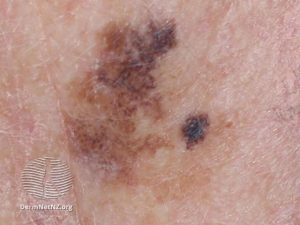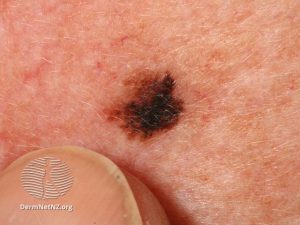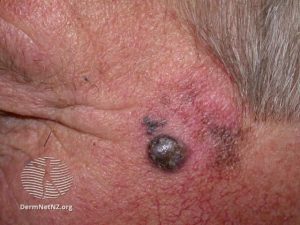
Melanoma is the most serious of the common types of skin cancer. If it is allowed to grow, melanoma can quickly spread to other parts of the body and be life threatening. When found and treated early, it is often highly treatable and often curable. Continue reading for more information on melanoma and melanoma treatment options.
Anyone can get melanoma, although it is more common in people with fair skin. It is caused by exposure to UV radiation from the sun or tanning beds. Risk is increased in sunny areas such as Florida or Arizona or high-altitude areas such as Colorado. Using indoor tanning beds before age 35 can increase one’s risk significantly, and the risk increases with each use. A history of blistering sunburns in childhood and adolescence also leads to a significantly increased risk for developing this type of skin cancer. Some families have numerous atypical moles, and people in these families are at higher risk for developing melanoma. People who have a first-degree relative (parent, sibling) who have had melanoma are at a higher risk than the overall population for also developing it themselves. Lastly, any disease or medication that weakens the immune system will increase the risk for melanoma.
It is important to learn about the warning signs and look for these signs when examining your own skin. It is also important to see a dermatologist right away if you find any of the warning signs. Warning signs to look for can be remembered by the “ABCDE”s of melanoma:
- Asymmetry: one half is unlike the other half
- Border: an irregular, scalloped, or poorly defined border
- Color: variations of tan, brown, black, and sometimes white, red, or blue
- Diameter: melanomas are usually greater than 6mm (size of a pencil eraser)
- Evolving: anything that looks like a mole but is changing while others aren’t

Having accurate information on how melanoma presents itself can help you to determine when it is time to seek melanoma treatment. It may appear as a new spot on the skin, a change to an existing mole, a spot that looks like a changing freckle or age spot, a dark streak in a fingernail or toenail, dark skin around a nail, or even a growing area of thick skin that looks like a scar. If you find anything that looks like it could be a melanoma, please make a dermatology appointment immediately.
In order to make the diagnosis, a dermatologist will perform close and careful examination of the skin and may use a dermatoscope to get a special magnified view of skin lesions that look suspicious for the disease. Your dermatologist may also feel lymph nodes, especially if you have already been diagnosed with melanoma. When a spot is found that is suspicious, your dermatologist will remove the lesion with a skin biopsy in order to make the diagnosis and to determine how deep the cancer is growing in the skin. The depth of a melanoma is important for determining its stage, which guides treatment decisions. If it has grown past a certain thickness or has other concerning features, your dermatologist will refer you to a surgeon to perform a sentinel lymph node biopsy at the same time as the surgery to remove the cancer. This type of biopsy is important to determine if it has spread past the original site of growth. Other tests may be ordered after this biopsy, including X-rays, blood work, or a PET/CT scan. If the original cancerous growth where it first appeared is very thin in the skin as determined by the first biopsy, then it may be removed in the dermatologists office by surgical excision while awake using only local anesthetic.

If a melanoma has been found to spread to other areas of the body, the patient will be referred to a medical oncologist for melanoma treatment. Radiation therapy may be used if there is one area or certain focused areas that the cancer has spread to. Medications used by a medical oncologist to treat metastatic melanoma may include chemotherapy, targeted therapy, or immunotherapy. Other treatments for advanced metastatic melanoma may include adoptive T-cell therapy, a clinical trial, or palliative care.
Outcome of treatment strongly depends on how deeply the melanoma has grown into the skin at its original site. If it has grown deeply before treatment, the risk of dying is high. If it is treated appropriately when it is caught early, the cure rate can be nearly 100%. Early detection is very important.
In the high-altitude climate of Colorado Springs and Monument, CO, it is important to take care of your skin and to be aware of signs that may indicate skin cancer. Having accurate information on melanoma and how it presents can lead to an early diagnosis that could result in a less intensive melanoma treatment, likely with a better outcome. If you are interested in learning more or scheduling a skin cancer screening, contact the dermatologists at Summit Dermatology today!
